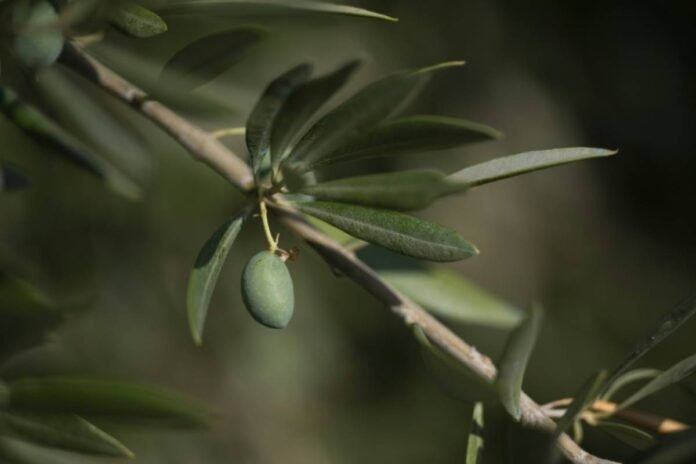An olive branch near Fuerte del Rey, July 21, 2022 in southeastern Spain (AFP / PIERRE-PHILIPPE MARCOU)
Improving irrigation, selecting new varieties, moving crops… Faced with global warming, which affects harvests and causes prices to rise, olive oil professionals are redoubling their efforts to develop solutions, connecting with the scientific world.
“Climate change is already a reality, we have to adapt to it,” Jaime Lillo, executive director of the International Olive Council (IOC), said Wednesday on the occasion of the first World Olive Oil Congress, which will gather 300 participants in Madrid until Friday .
A painful “reality” for the entire sector, which for two years faced a drop in production on an unprecedented scale, against the background of heat waves and extreme drought in the main producing countries, such as Spain, Greece or Italy.
According to the COI, global production fell from 3.42 million tonnes in 2021-2022 to 2.57 million tonnes in 2022-2023, a drop of about a quarter. And in light of the data submitted by the organization’s 37 member countries, it should fall again in 2023-2024 to 2.41 million tonnes.
This situation has caused prices to rise from 50% to 70% depending on the varieties in question in the past year. In Spain, which supplies half of the world’s olive oil, prices have even tripled since the start of 2021, much to the dismay of consumers.
– “Complex scenarios” –
“The tension in the markets and the escalation of prices constituted a particularly delicate + stress test for our sector, we had never experienced this before,” assured Pedro Barato, president of the interprofessional oil organization.
Olive fields near Banos de la Encina, July 21, 2022 in southeastern Spain (AFP / PIERRE-PHILIPPE MARCOU)
“We need to prepare for increasingly complex scenarios that will enable us to cope with the climate crisis,” he continued, comparing the situation of olive growers to the “turbulence” experienced by the banking sector in the 2008 financial year.
The outlook is actually not very encouraging.
Today, more than 90% of the world’s olive oil production comes from the Mediterranean region. But according to the Intergovernmental Panel on Climate Change (IPCC), this region – described as a climate change “hot spot” – is warming 20% faster than average.
A situation that can affect global production in the long term. “We are facing a delicate situation” which involves “changing the way we treat trees and soil”, summarizes Georgios Koubouris, researcher at the Greek Olive Institute.
“The olive tree is one of the plants best adapted to a dry climate. However, in the case of extreme drought, it activates mechanisms to protect itself and no longer produces anything. To have olives, you need a minimum of water “, Jaime Lillo insists.
– Genetics and drip –
Among the solutions put forward in Madrid is genetic research: for several years, hundreds of varieties of olive trees have been tested to identify the species most adapted to climate change, in particular based on their flowering date.
The goal is to find “varieties that need fewer hours of cold in winter and are more resistant to stress caused by a lack of water at certain key times of the year”, such as spring, summarizes Juan Antonio Polo, responsible for technological issues at COI.
The other major area that the researchers are working on concerns irrigation, which the sector wants to develop through rainwater storage, wastewater recycling or seawater desalination, while improving its “efficiency”.
This involves abandoning “surface irrigation” and generalizing “drip systems”, which bring water “directly to the roots of the trees” and help avoid losses, insists Kostas Chartzoulakis of the Greek Olive Institute.
In order to adapt to the new climatic situation, a third, more radical approach is also being considered: abandoning production in certain areas, which may become unsuitable because they are too deserted, and developing it in others.
This phenomenon “has already begun”, although on a small scale with the emergence of “new plantations” in regions that have so far been alien to the cultivation of olive trees, specifies Jaime Lillo, who says he is “optimistic” for the future, despite the challenges that he faces. the sector.
“Thanks to international cooperation, we will little by little find the solutions,” he promises.
